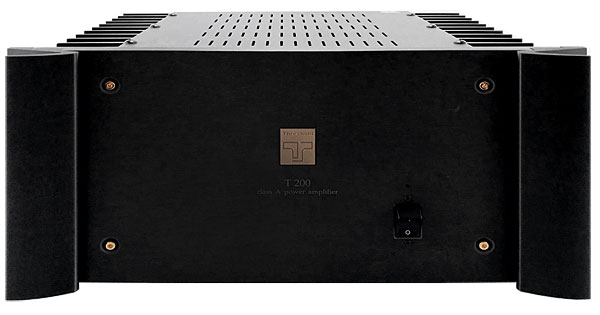| Columns Retired Columns & Blogs |
"Stasis" ........... Code 64 :-) ..........

Then, early in 1994, an announcement came of the acquisition of Threshold Corporation by a group of investors headed by Randy Patton, co-owner of PS Audio. Randy is known as a shrewd businessman and a dedicated audiophile; PS Audio became a significant force in the marketplace under his leadership (footnote 2). According to Randy, Threshold is far from being "in trouble," and has "a reassuringly solid financial base to work from. We have a dedicated workforce in place, and a new line of products." One of these products is the T-200 amplifier, designed by Michael Bladelius, the Swedish engineer responsible for the Forté 4A (footnote 3).
Description & design
Except for the binding posts, which appear to be your standard-issue plastic-knob variety, the T-200 has the quality look and feel of a true high-end amplifier. Fit and finish are excellent, and the 5/8"-thick faceplate sports sculpted handles. Inputs are switch-selectable between unbalanced RCA and balanced XLR. Another switch (safety-locked) selects between stereo and mono operation. Rated at 100Wpc into 8 ohms, the T-200 can be bridged for mono operation, in which case it puts out 350W into 8 ohms. Although the amp is quite heavy, the front and rear handles make it easy to move around. The T-200's four non-spiked feet didn't provide enough clearance for heat dissipation when the amp was placed directly on the thick carpet of my listening room, so I put a large butcher-block type cutting board on the carpet, and placed the amp on the cutting board. This allowed for the requisite ventilation (the T-200, as a class-A design, runs quite warm), and for reasonably firm support.
The T-200 is the second from the top in a new line of four amplifiers whose claim to design fame is the use of a device called the Insulated Gate Bipolar Transistor (IGBT). As I understand it, the IGBT—also used in the Forté 4A and by Counterpoint in some of their Natural Progression amplifiers—is a sort of hybrid between the conventional bipolar transistor and the MOSFET. Like the bipolar transistor, it has a high-current, low-impedance output, and a high input impedance like the MOSFET. The IGBT device is also said to have ten times the MOSFET's forward-transfer admittance, which sounds like it's a good thing to have. (The result, sez Threshold, is lower crossover distortion, which is a good thing to have.)
Manufactured by Toshiba, IGBTs have been around for a while, but only recently have become available in carefully matched complementary pairs specifically designed for audio use. The T-200 uses 16 matched IGBTs per channel. Threshold admits that, as with any device, IGBTs have disadvantages as well as advantages. The disadvantages in this case include high sensitivity to temperature change, and much higher cost than even the most expensive transistors or MOSFETs. They've dealt with the potential temperature problem by using a proprietary thermal bias-tracking circuit, and as for the cost—well, hang the cost, it's only money! According to Threshold, the same basic circuit was built with bipolar transistors, MOSFETs, or IGBTs during the development phase, and the IGBT-based design was clearly preferred in listening tests.
Of course, an active device does not an amplifier make, but the T-200's design and construction has all the other good things one expects in an amplifier of its pedigree. It operates in class-A, employs only minimal feedback, is direct-coupled input to output (the circuit apparently has so little DC drift that no servo correction is needed), and utilizes close-tolerance metal-film resistors, a large custom toroidal transformer, 128,000µF filter capacitance, and separate power supplies for voltage and current gain-stages.
The T-200 is protected from overload and short circuits by fast-blow fuses, accessed by removing the cover. I managed my usual trick of shorting the speaker cables, and one of the fuses did blow—and fast—so there was no damage to the amplifier. The type of fuse is sufficiently exotic that the guy at my neighborhood Radio Shack just shook his head in bewilderment when he looked at it. Threshold quickly Fed-Exed me a full set of fuses; they might consider including a set with each amp in case consumers are as butterfingered as reviewers.
Compatibility Issues
I tried both balanced and single-ended connections between the Sonic Frontiers SFL-2 and the Threshold T-200 (the CAT SL-1 Signature is single-ended only), and, to my surprise, found that the bass response was much weaker with the balanced connection.
Footnote 2: In 1995, PS Audio was a subsidiary of Threshold Corporation.
Footnote 3: Michael Bladelius now works for the Canadian Classé company, commuting from his home in Sweden.—John Atkinson

"Stasis" ........... Code 64 :-) ..........